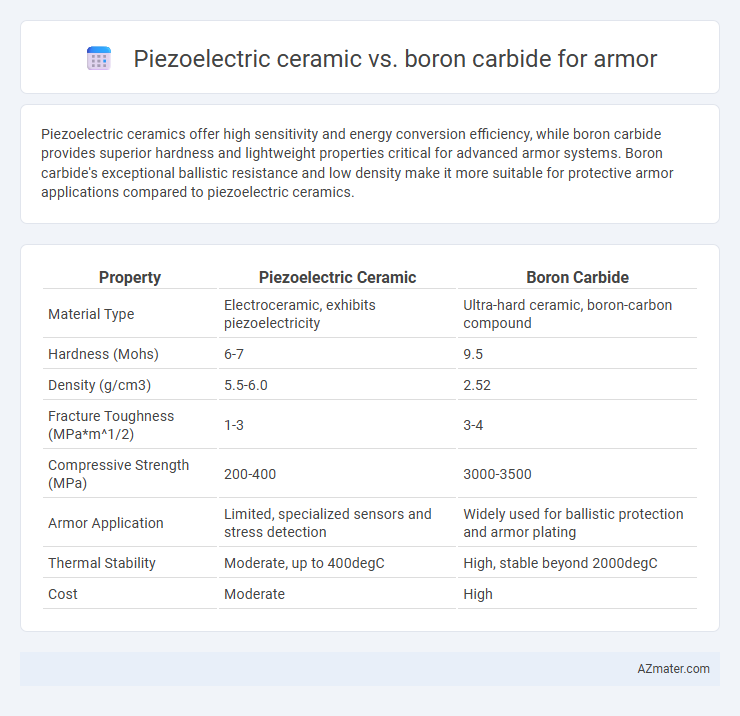Piezoelectric ceramics offer high sensitivity and energy conversion efficiency, while boron carbide provides superior hardness and lightweight properties critical for advanced armor systems. Boron carbide's exceptional ballistic resistance and low density make it more suitable for protective armor applications compared to piezoelectric ceramics.
Table of Comparison
| Property | Piezoelectric Ceramic | Boron Carbide |
|---|---|---|
| Material Type | Electroceramic, exhibits piezoelectricity | Ultra-hard ceramic, boron-carbon compound |
| Hardness (Mohs) | 6-7 | 9.5 |
| Density (g/cm3) | 5.5-6.0 | 2.52 |
| Fracture Toughness (MPa*m^1/2) | 1-3 | 3-4 |
| Compressive Strength (MPa) | 200-400 | 3000-3500 |
| Armor Application | Limited, specialized sensors and stress detection | Widely used for ballistic protection and armor plating |
| Thermal Stability | Moderate, up to 400degC | High, stable beyond 2000degC |
| Cost | Moderate | High |
Introduction to Advanced Armor Materials
Piezoelectric ceramics exhibit unique electromechanical properties making them suitable for sensor integration and impact detection in advanced armor systems, enhancing threat assessment capabilities. Boron carbide, one of the hardest known materials, offers exceptional ballistic resistance and lightweight protection ideal for personal and vehicular armor applications. Combining the energy absorption of piezoelectric ceramics with the hardness of boron carbide results in multifunctional armor materials that improve both survivability and situational awareness on the battlefield.
Overview of Piezoelectric Ceramic in Armor Applications
Piezoelectric ceramics offer unique advantages in armor applications due to their ability to convert mechanical stress into electrical signals, enabling real-time damage detection and impact monitoring. Their high sensitivity and durability facilitate enhanced structural health monitoring systems in advanced protective gear. Compared to conventional materials like boron carbide, piezoelectric ceramics integrate sensing capabilities, improving armor responsiveness without significantly increasing weight.
Boron Carbide: Properties and Armor Performance
Boron carbide exhibits exceptional hardness (approximately 9.5 on the Mohs scale) and a low density of about 2.52 g/cm3, making it one of the lightest and hardest materials suitable for armor applications. Its high compressive strength and excellent fracture toughness contribute to superior ballistic protection by effectively dissipating kinetic energy from high-velocity impacts. In contrast to piezoelectric ceramics, boron carbide's mechanical robustness and lightweight nature make it the preferred choice for body armor, vehicle armor, and protective panels in aerospace and military sectors.
Comparative Mechanical Strength
Piezoelectric ceramic exhibits high hardness and moderate fracture toughness, enabling effective energy absorption and impact resistance in armor applications. Boron carbide, known for its exceptional hardness and low density, offers superior ballistic protection but suffers from brittleness and susceptibility to catastrophic failure under high stress. When comparing mechanical strength, boron carbide provides higher hardness and better protection against penetration, whereas piezoelectric ceramics offer enhanced fracture toughness, contributing to improved durability under dynamic loads.
Impact Resistance and Energy Absorption
Piezoelectric ceramics exhibit excellent hardness and brittleness, offering limited energy absorption but high impact resistance through stress wave generation. Boron carbide surpasses piezoelectric ceramics in impact resistance due to its superior hardness and fracture toughness, enabling efficient energy dissipation and minimal penetration under ballistic impacts. The combination of boron carbide's low density and high compressive strength makes it ideal for lightweight armor applications demanding maximum energy absorption and shock resistance.
Weight and Flexibility Considerations
Piezoelectric ceramics offer higher stiffness but are significantly heavier and more brittle compared to boron carbide, impacting overall armor weight and resilience. Boron carbide provides superior lightweight protection with enhanced flexibility, making it ideal for applications requiring high mobility and reduced fatigue. The trade-off between the stiffness of piezoelectric ceramics and the lightweight, flexible properties of boron carbide drives material selection based on specific armor performance needs.
Durability and Longevity in Field Conditions
Piezoelectric ceramics exhibit high durability under repetitive mechanical stress but may degrade faster in extreme environmental conditions compared to boron carbide, which offers superior hardness and excellent resistance to wear and impact, ensuring prolonged longevity in harsh field environments. Boron carbide's exceptional fracture toughness and chemical stability make it the preferred choice for armor applications requiring sustained performance against ballistic threats. While piezoelectric ceramics provide useful multifunctionality, boron carbide's proven resilience and durability are critical for long-term armor reliability.
Cost-Effectiveness and Manufacturing
Piezoelectric ceramics offer moderate cost and relatively straightforward manufacturing processes, making them suitable for applications requiring sensor integration within armor systems. Boron carbide, though significantly more expensive due to its complex synthesis and machining challenges, provides superior hardness and lightweight properties essential for high-performance ballistic protection. The trade-off between piezoelectric ceramics' cost-effectiveness and boron carbide's exceptional durability guides material selection based on specific armor performance and budgetary requirements.
Recent Innovations and Research Trends
Recent innovations in piezoelectric ceramics for armor focus on enhancing energy absorption and impact detection through multifunctional composite materials that convert mechanical stress into electrical signals. Boron carbide research emphasizes improving fracture toughness and ballistic resistance by developing nanostructured and hybrid formulations that offer superior lightweight protection. Advances in additive manufacturing and surface engineering techniques have accelerated the tuning of both materials for optimized performance in next-generation armor systems.
Conclusion: Choosing the Optimal Armor Material
Piezoelectric ceramics offer superior energy absorption and self-sensing capabilities, making them ideal for adaptive armor systems. Boron carbide excels in hardness and lightweight protection, ensuring high ballistic resistance with minimal weight. Selecting the optimal armor material depends on balancing energy dissipation with structural strength and application-specific requirements.

Infographic: Piezoelectric ceramic vs Boron carbide for Armor
 azmater.com
azmater.com